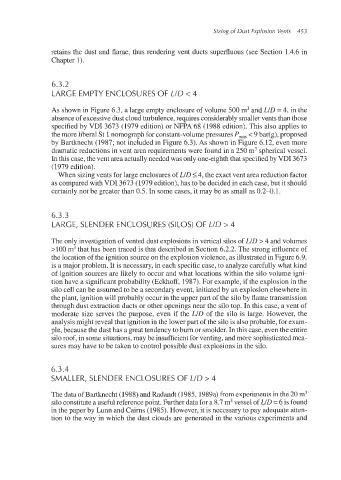Page 486 - Dust Explosions in the Process Industries
P. 486
Sizing of Dust Explosion Vents 453
retains the dust and flame, thus rendering vent ducts superfluous (see Section 1.4.6 in
Chapter 1).
6.3.2
LARGE EMPTY ENCLOSURES OF LID < 4
As shown in Figure 6.3, a large empty enclosure of volume 500 m3 and LID = 4, in the
absence of excessivedust cloud turbulence, requires considerably smaller vents thanthose
specified by VDI 3673 (1979 edition) or NFPA 68 (1988 edition). This also applies to
the more liberal St 1nomograph for constant-volumepressures P,,, < 9 bar(g), proposed
by Bartknecht (1987; not included in Figure 6.3). As shown in Figure 6.12, even more
dramatic reductions in vent area requirements were found in a 250 m3spherical vessel.
In this case, the vent area actually needed was only one-eighththat specifiedby VDI 3673
(1979 edition).
When sizing vents for large enclosures of LlD 5 4, the exact vent area reduction factor
as compared with VDI 3673 (1979 edition),has to be decided in each case, but it should
certainly not be greater than 0.5. In some cases, it may be as small as 0.2-0.1.
6.3.3
LARGE, SLENDER ENCLOSURES (SILOS) OF LID > 4
The only investigation of vented dust explosions in vertical silos of LID > 4 and volumes
>I00 m3that has been traced is that described in Section 6.2.2. The strong influence of
the location of the ignition source on the explosion violence, as illustrated in Figure 6.9,
is a major problem. It is necessary, in each specific case, to analyze carefully what kind
of ignition sources are likely to occur and what locations within the silo volume igni-
tion have a significant probability (Eckhoff, 1987).For example,if the explosion in the
silo cell can be assumed to be a secondary event, initiated by an explosion elsewherein
the plant, ignition will probably occur in the upper part of the silo by flame transmission
through dust extraction ducts or other openings near the silo top. In this case, a vent of
moderate size serves the purpose, even if the LID of the silo is large. However, the
analysis might reveal that ignition in the lower part of the silo is also probable, for exam-
ple, because the dust has a great tendency to burn or smolder. In this case, even the entire
silo roof, in some situations,may be insufficient for venting, and more sophisticatedmea-
sures may have to be taken ts control possible dust explosions in the silo.
6.3.4
SMALLER, SLENDER ENCLOSURES OF LID > 4
The data of Bartknecht (1988) and Radandt (1985,1989a) from experimentsin the 20 m3
silo constitute a useful referencepoint. Further data for a 8.7 m3vessel of LID =6 is found
in the paper by Lunn and Cairns (1985).However, it is necessary to pay adequate atten-
tion to the way in which the dust clouds are generated in the various experiments and

